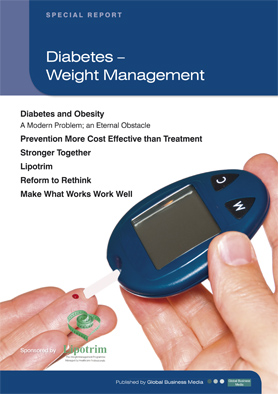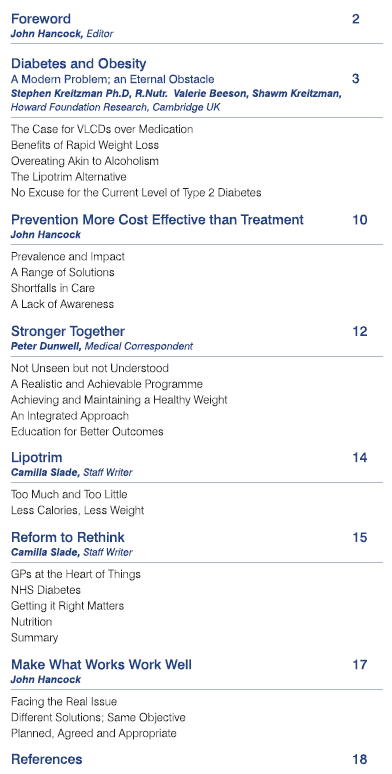Shown at:
NICE Conference 2009,
NHS Alliance Conference 2011,
NHS Alliance Conference 2012,
Author Archives: Lipotrim
Dr Haslam on lipotrim
Professor David Haslam
Chairman: National Obesity Forum
Discusses Lipotrim
CONTRASTING THE BENEFITS OF VERY LOW CALORIE DIETS AND BARIATRIC SURGERY
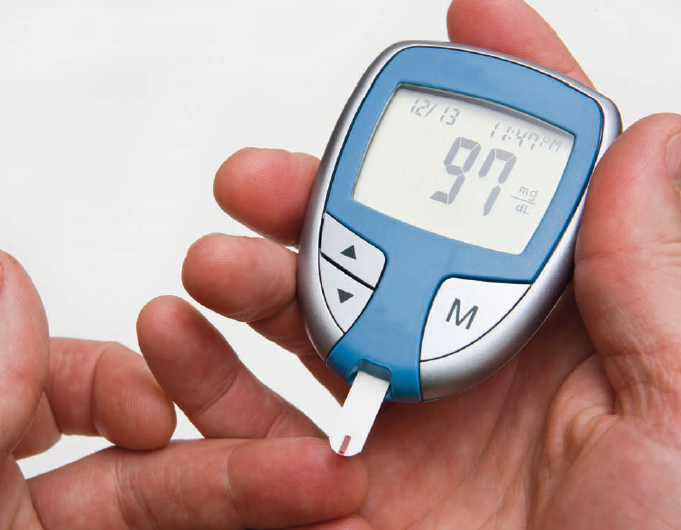 By S.N Kreitzman,V. Beeson and S.A. Kreitzmanof Howard Foundation Research Ltd
By S.N Kreitzman,V. Beeson and S.A. Kreitzmanof Howard Foundation Research Ltd
Interest in the use of weight loss to treat type 2 diabetes has been intensifying in recent years, despite the fact that the rapid therapeutic effect of weight loss on type 2 diabetes has been
well documented for decades and has been hitherto largely ignored. The current interest may be attributed in large part to a number of publications generated by evidence (from bariatric surgery) of the almost universal prompt remission of diabetes with weight loss after successful surgery.
One such study was published in the Journal of Endocrinology and Metabolism in 2004 by Cummings et al – ‘Gastric Bypass for Obesity:
Mechanisms of Weight Loss and Diabetes Remission’. In support of their efforts to promote the use of surgical techniques, the authors claimed that no more than 5-10 per cent of body weight can be lost through dieting, exercise or the few available anti-obesity medications. They further write, correctly, that: “Importantly, even mild weight loss confers disproportionate health benefits, in terms of ameliorating obesity-related comorbidities. Nevertheless more substantial and durable weight reduction would improve these ailments more effectively.”
And not correctly that:
“At present, bariatric surgery is the most effective method to achieve major weight loss. The best operations reduce body weight by 35-40 per cent.”
Quite a dramatic claim, but surgery is not the only effective means of achieving this amount of weight loss when necessary.
The very low Calorie diet
There is a readily available alternative to bariatric surgery, without the problematic aspects of bariatric surgery:
high morbidity and mortality risk, prohibitively high cost, possible post-operative addiction transfer and (in consideration of the large numbers of severely overweight people with or without diabetes) extremely limited availability. This alternative is the very low Calorie diet.
Detailed records have been kept of the weight loss results from GP practices and pharmacies. Using audit data, accumulated from UK pharmacies, it was possible to document cases where
dieters successfully lost in excess of 35 per cent of their pre-diet weight. These pharmacy weight loss programmes are based upon a replacement of all normal foods with a nutrient complete formula. There are many advantages to this approach over bariatric surgery, especially with severely overweight people. There is now an expanding literature – based upon numerous investigations into addiction – which demonstrate that in a considerable percentage of high BMI people, the same metabolic pathways that are generally recognised as part of the addiction profile are shared by people who are using food as a substance of abuse. In the case of every known addiction it is absolutely necessary to completely stop the abused substance. This is difficult when the substance in question is alcohol, tobacco or drugs; it is literally unachievable when the addictive substance is food, which is required in order to stay alive. While ultimately food is required for energy, there is no shortage of energy stored as fat and glycogen in overweight people. What must be supplied in order to keep people healthy are the vitamins, minerals, trace elements, essential amino acids and essential fatty acids. Depletion of any of these nutrients will compromise health. Post bariatric surgery patients are expected to reintroduce foods in limited quantities. In contrast, use of a nutrient complete formula provides all the essential nutrients in the absolute minimum number of Calories. This allows weight loss at the maximum safe rate, while allowing the person to completely stop eating the foods that they are abusing. This is the only approach that will interfere with the addictive problem and offer a reasonable chance of establishing a normal relationship with food in the future.
Counting the Calories
There is yet another important benefit to using a foodreplacement formula instead of traditional foods. Traditional foods are derived from various plants and animals and naturally differ in nutrient composition and Calorie contribution, so it is not possible to get an accurate estimate of the energy intake. Food composition tables (which present averages from a large number of samples) can differ widely from the composition of a specific sample. In contrast, the Caloric composition of a defined formula can be known with considerable precision. Dieters therefore can know exactly the number of Calories they are eating each day. It is well known that the Calorie deficit required to lose a pound of body fat is fixed at 3,500. The difference between the Calories in the formula and the Calories used by the individual based upon genetics and lifestyle will represent the rate at which the 3500 Calories is being depleted. Calorie utilisation for most people, especially severely overweight people who are not usually involved in massive exercise programmes, does not vary a great deal from day to day. Variations are trivial when it is realised that running a mile only consumes an additional 100 Calories, so the number of Calories used each day is basically constant. This explains the essentially straight line pattern of weight loss with VLCD. From the daily changes in weight, it is easy to determine the number of Calories used by each individual day after day. This then will inform the individual of the critical Calorie intake that will determine whether weight is gained, lost or maintained. There is no other method to gain this information under real life conditions. Cummings et al, in the paper cited above, provide estimates of the cost of bariatric surgery (2004 data) represented as QALY (quality adjusted life years), ranging from 5,400 to $36,300, which they state is well under the $50,000 generally regarded in the United States as being cost effective. It might be worth considering a VLCD pharmacy programme
which will routinely provide weight losses of one stone (6.3 kg) a month for women and one and a half stone (10 kg) for men. And unlike bariatric surgery, the programmes can be used with people who have far less weight to lose than the BMI 35-40 subjects reported here. These programmes are even suitable for obesity prevention in overweight (but not yet obese) individuals who fall into the range of BMI 25-30. This is a far more appropriate contribution to public health and prevention of diabetes.
Weight loss and type 2 diabetes
Type 2 diabetes is a disease of excess weight. There are countless thousands of papers in the literature that concur with this statement. It would seem to be obvious therefore that treatment protocols should focus on rapid and effective weight loss for patients with diabetes. If one thinks ‘diabetes is excess weight’, one would be right most of the time.
Conventional weight loss options have generally proven so unreliable that it is understandable and (almost) forgivable that weight loss is not vigorously promoted for treatment of
type 2 diabetes. Nevertheless, there is a much better option than bariatric surgery for weight loss. Worldwide research spanning a period approaching 40 years has repeatedly
demonstrated that sufficient weight loss to treat diabetes can be achieved, and indeed is currently being achieved in the UK and Ireland by a large number of pharmacists.
Furthermore, fully established diabetes is only part of the problem (even though the UK is reported to be spending about £9 billion a year dealing with diabetes).
There is also a well recognised pre-diabetes syndrome with resistance to insulin, hypertension and elevated blood sugar and lipids, the so-called syndrome X. The best recognised treatment is also, of course, weight loss. A very detailed meta-analysis and review of co-morbidities related to obesity and overweight from British Columbia, published in 2009, identified 18 co-morbidities contributing, according to the authors, to a very large future disease burden as weight continues to be a medical problem. Pharmacists deserve considerable recognition for providing a service for remission of diabetes and relief of co-morbidities, where present, without depleting the assets of the National Health Service.
And, crucially, praise for the effective treatment of excess weight in hundreds of thousands of documented patients.
PDF version: contrast vlcd & surgery pharmicist 2012(1)
WEIGHT GAIN LOSS OR MAINTENANCE – TRACKING THE CALORIE BALANCE POINT
S.N Kreitzman Ph.D, R.Nutr. (UK Registered Nutritionist), & V. Beeson Howard Foundation Research Ltd. Cambridge UK
It is widely understood that weight loss, weight gain or weight maintenance is determined by the relationship between Calories eaten compared with Calories used. For each individual, with unique genetics and distinctive lifestyles, it makes sense that the Calorie balance point will differ between people – along with individual differences in almost every other aspect of life. Yet we are expected to take the values of 2000 Calories a day for women and 2500 Calories a day for men as fixed balance points and when reality proves different we are expected to censure the individual.

The true energy balance level – the Calorie intake level that will provide for weight maintenance rather than gain or loss
for an individual, is a very important piece of information. Weight maintenance is the most difficult aspect of weight control and without an accurate determination of the critical equilibrium Calorie level, people must rely on guesswork. A successful outcome becomes very unlikely.
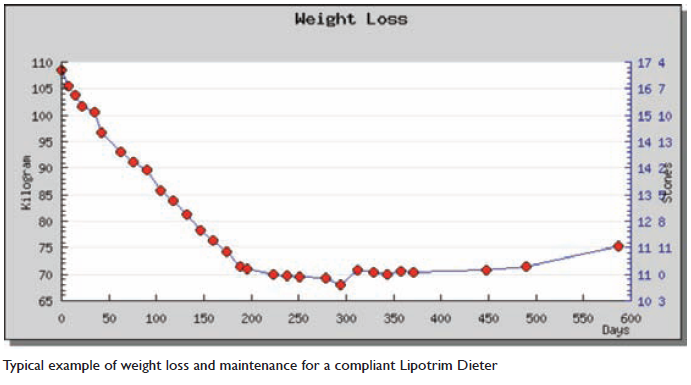
Measuring the energy expended by people living normal lives is almost impossible. There are techniques using double isotope labelledwater, which are extremely expensive and virtually never used. Fortunately, whatever the energy levels used by individuals, they are surprisingly consistent. The reason for this is that despite the unrealistic claims for a massive Calorie usage with exercise equipment, the reality is much more depressing. A mile run uses about 100 extra Calories, not far from the contribution provided by a sports drink. Using up a pound of body fat, however, requires a deficit of 3500 calories. Few seriously overweight people have the capacity to run the 35 miles it takes to lose an extra
pound of fat weight. So, Calories used each day for most people are remarkably consistant. What about intake? Under most conditions it is extremely difficult to measure actual daily intake. There has been, however, an exciting benefit from the auditing of weight loss results with dieters using the Lipotrim pharmacy service. The vast majority of compliant dieters S.N Kreitzman Ph.D, R.Nutr. (UK Registered Nutritionist), & V. Beeson Howard Foundation Research Ltd. Cambridge UK haveweight loss experiences that follow the pattern seen in the case shown here. Many pharmacies have hundreds of such cases. It should be obvious that the weight loss over a fixed time is virtually the same, week after week. This must mean that essentially the same amount of fat is being depleted every day, and since the Calories provided
by the Lipotrim diet formulas are constant, the calories the body must provide to make up the difference between the amount eaten and the amount used (defined as dieting) must be about the same every day
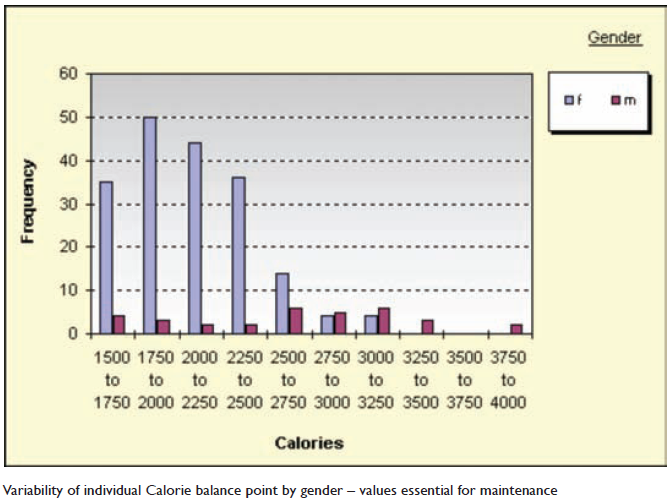 .
.
The patient record keeping and audit tool, the Lipotrim Patient Tracker, used by many pharmacies running the service
has now been augmented to display the Calories used by each compliant dieter. Assessing the Calories used per day by
220 dieters treated by pharmacist, Gareth Evans, yielded on average 2171 Calories, however comparing the 187 females with the 33 males in the sample yielded an average Calorie usage of 2084 for women and 2666 for men. Quite realistic averages. The reality, however, for individuals can be considerably different from the group averages. The graph below shows the actual distribution of equilibrium Calories. Thirty one percent of the women had Calorie expenditures above 2000 and forty five percent had values below 2000 – some far below. These people will have vastly different maintenance experiences if they adhere to a 2000 Calorie a day maintenance regime. While there are fewer men in the sample, it is clear that there is a substantial spread in the individual values and about 33% of this cohort are below the 2500 classic value. There is yet another critically important consequence of identifying the equilibrium value for Calorie intake that determines whether there will be maintenance, gain or loss. There have been articles in the press in recent months suggesting that weight lossis trivially easy. The notion that cutting out a piece of toast a day (about 80 Calories) if
done every day will result in a loss of over 8 pounds in a year can not be valid because seriously overweight and obese people are not eating at the equilibrium intake. Yes it would be true for an individual with a personal maintenance level of 2000 Calories and who was consistently eating at that level to lose weight by cutting 80 Calories a day out of their daily intake. It is unrealistic to think that a seriously overweight person is habitually eating 2000 calories a day. Eating 80 calories less than the typical, 3000 Calories (pick a different excessive number if you don’t like 3000) will only slow the weight gain a bit. The application of the Patient Tracker software is advancing the understanding of weight loss and maintenance of real people and also documenting the substantial impact on the management of weight related medical problems such as type 2 diabetes and hypertension. It is also providing valuable data which is satisfying the need for evidence based treatment.
PDF version: 2-7-napc-calorie-balance-point
SHARING WEIGHT MANAGEMENT ADVICE WITH PATIENTS
We all know that the key to weight loss is eating less and exercising more. However, dropping to under 1,200 calories without supplementation leads to nutrient deficiencies, which perpetuates the myth that lower calorie diets are dangerous
It is comforting to know that nurses are one of the few groups left who understand the suffering experienced by patients who are overweight and who recognise obesity as a problem worthy of effective action. Weight control is difficult and unfortunately it is much easier to eat calories than it is to exercise them away. A calorie gap of 3,500 calories between the calories eaten and those used is necessary to dispose of a single pound of excess body fat – 3,500 calories represent
a substantial amount of exercise. If the calories actually eaten are more than the calories used by the other activities of the day, the exercise will only reduce the calorie excess and not result in weight loss. It might, however, slow the weight gain. It really is necessary to eat less in order to manage weight.
No easy solution
There is no secret to weight management: the calories eaten have to be considerably less than those being used for a sustained period of time. The continued health of the patient requires them to consume all the essential nutrients necessary for life and health, which becomes increasingly difficult as the amount of food consumed is reduced or treatments actively promote malabsorption.
If we maintain a varied selection of foods, we can feel reasonably confident that we are getting the complete array of essential nutrients. However, while the plants and animals we choose for food each have some of the essential nutrients required by man, none has them all. To get the right amounts for sustained health from unsupplemented foods it is absolutely essential that we eat in excess of 1,200 calories. Eating foods with lower calorie totals cannot provide all the nutrients that we need. The myth that dropping calories below about 1,200 in order to lose weight is unhealthy is true, but not because the calories are low – a fat person has an enormous store of calories available. The problem is that dieters become nutrient deficient.
Providing the missing nutrients, however, permits dropping the calorie intake much further without harm, as long as there are reserves of fuel left in the body. Fuels available for the body are glucose (stored as glycogen) and fat. An obese individual has about 37,000 calories in reserve for each stone of excess weight and therefore has no realistic need to eat more. He just needs to get the essential nutrients. When these come from a nutrient-complete formula food, the results are ideal: complete nourishment and minimal calories. Supplying the essential nutrients in a prepared mixture, such as in an enteral feed, assures that nutrient deficiencies do not occur.
The role of the pharmacist
An expanding network of pharmacists is offering a range of treatments for weight problems. They have the training, the respect of the public, the contact hours and the desire to offer weight management as a professional service. NICE recommends that specialists be used for extended very low calorie diets (VLCDs).1 These pharmacists are trained and experienced specialists in the use of VLCD.
Pharmacies following this route are achieving a great deal and GPs and nurses are becoming much more comfortable directing overweight patients to these highly trained and experienced pharmacists. At the same time the availability of trained pharmacists is becoming more widespread, which is making these experts much more accessible to a wider deserving population.
Conclusion
Weight loss is more than a cosmetic issue. Weight loss can lower blood pressure, normalise blood lipids, practically
eliminate type 2 diabetes, reduce the severity of asthma, bring relief to arthritics, increase the fertility of women, relieve sleep apnoea, provide an opportunity for patients to be considered for elective surgery, decrease the need for antidepressants, make exercise more possible and thus improve cardiovascular health, and vastly improve the quality of life for patients in a prejudiced and intolerant world. Pharmacists are emerging as the weight management specialists, providing lifestyle advice, effective treatments and support, as well as follow-on help for the most difficult aspect of managing weight: the longterm maintenance of weight lost. Your overweight patients will appreciate knowing about it.
PDF version: 4-3-sharing-advice
ADVANCED OBESITY MANAGEMENT TRAINING SOLUTIONS
S.N Kreitzman Ph.D. (Nutritional Biochemistry) R.Nutr. (UK Registered Nutritionist),
S. A. Kreitzman, & V. Beeson Howard Foundation Research Ltd. Cambridge UK
THE EFFECTIVENESS OF VERY LOW CALORIE DIETS IN MANAGING OBESITY
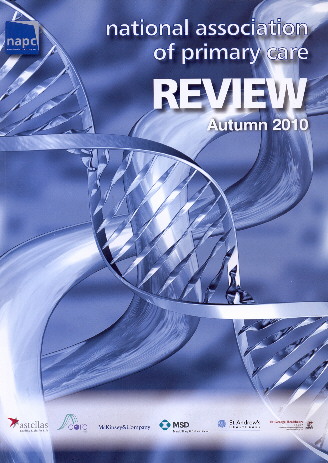 Obesity is a serious problem in modern society, and one that needs to be urgently addressed by healthcare professionals. Unfortunately, widespread obesity management will not be possible until healthcare professionals accept the brutal fact that advising an obese patient to ‘eat less” is as misguided as managing an alcoholic by advising him or her to “drink less.”
Obesity is a serious problem in modern society, and one that needs to be urgently addressed by healthcare professionals. Unfortunately, widespread obesity management will not be possible until healthcare professionals accept the brutal fact that advising an obese patient to ‘eat less” is as misguided as managing an alcoholic by advising him or her to “drink less.”
In the first instance, advanced obesity management must recognise that there is a difference between people who become .)ese and the rest of the normal weight j,opulation. Not every drinker becomes an alcoholic, and in the same way, only some people become obese. This is not a trivial comparison. Many people can and do control their eating behaviour arid never appear to be in danger of escalation into obesity. For those who do become obese, however, their food behaviour often displays the compulsions and cravings of an addiction. Indeed, it is when food consumption is put into the context of other addictive behaviours that the nature of the roblem
becomes clear.
The link between addiction and obesity is finally now being reflected in the search for drugs to combat obesity, as can be seen
in the 30 July, 2010 report in the Lancet on the use of naltrexone in conjunction with bupropion as a weight loss treatment. It is important to recognise the basic fact that there is a component of addiction in food abuse and ultimately obesity. The most powerful long term treatment for addictions is complete abstinence from the addictive substance. A reformed smoker is someone who does not smoke, and a reformed alcoholic is someone who does not drink Comprehending this simple reality explains why total food replacement formula (very low calorie diets) are extremely effective and conventional low calorie diets are much less effective for seriously overweight patients. To treat any addiction (including obesity) effectively it is necessary to stop the substance of abuse. Very low calorie diets – essentially low fat enteral feeds – are absolutely necessary because they permit a patient to safely stop eating for prolonged periods. No lifestyle or behavioural change can be effective while the patient is caught in the biological quagmire of addiction. The advantage of a Total Food Replacement programme is that nutrition is provided by an engineered
formula that is nutritionally complete, 
allowing the dieter to remove the addictive substance (food) from his or her life and remain healthy while the weight is lost. The value of a total food replacement formula programme in the treatment of overweight and obesity should now be obvious. TOTAL food replacementis the only means by which those who are subject to food abuse may avoid the addictive stimulus that perpetuates their weight problem.
EVIDENCED BASED CARE
The rapid proliferation of type 2 diabetes is currently one of the more serious healthcare problems. Current estimated costs to the NHS for treatment of this problem are a staggering El million per hour. In almost all cases however, a simple treatment exists that costs the NHS nothing, can normalise blood sugars within a few days (even in long standing diabetes) and in most cases actually put type 2 diabetes into remission. This important clinical knowledge is inadequately recognised because of the mantra for evidence based care. It is impossible to design a double blind placebo controlled study of VLCD.
While case studies are often considered to be a lesser level of evidence, the balance of believable evidence must shift, especially when the number of cases being audited becomes virtually the entire treatment population. For the past 25 years GPs and pharmacists have been treating overweight and obese patients with VLCDs and monitoring their progress weekly over the course of their treatment. Those medical details and weekly progress reports have all been recorded over the years, and a number of audits from individual GP
practices and a 25 practice meta-audit have been published.
As the population of GP practices and pharmacies has expanded and computerised patient records have become more available, it has become Training to use VLCD properly requires education
Dieters can safely remove the addictive substance (food) and remain healthy theoretically possible to audit the entire population. A sample from a group of pharmacies in the Republic of Ireland has provided audit data for over 9000 Lipotrim patients. A single pharmacy in Prestwich, Manchester has provided audit data for over 1100 dieting Lipotrim patients. Since these patients are seen weekly and progress recorded by health professionals, the information should be viewed as highly credible and EVIDENCE BASED.
At Prestwich 1148 overweight patients with a median BMI of 33.6 kg/m’ were enrolled into the Lipotrim weight management programme. Of these, 25% were morbidly obese with a BMI >40 kg/ m2. At the time of audit, during which manypatients were still actively dieting, the median BMI had decreased to <30 kg/m2. 94% of the dieters lost more than 5% of their pre-diet weight, 47% lost more than 10% and 21% of the patients lost more than 20%. Importantly, all patients with type 2 diabetes had their medication stopped by their GP.’ The weight losses (comparable in most cases to that achieved by bariatric surgery) are having the same effect on type 2 diabetes as that reported for surgical procedures. The effect is in fact so dramatic, patients are not permitted to start the diet unless the GP has stopped diabetic medication. Blood sugars will normalize within a few days, and with afew weeks weight loss it is unlikely that any further diabetic medication will be required.
Training to use VLCD properly requires education. There are simply too many myths. The training programme for pharmacists running the Lipotrim weight management programme was awarded the SMART Best Educational Training Award For Pharmacists in 2002. Based upon sound physiological principles that most professionals know but are continuously seduced to ignore, there must be a greater recognition of need for VLCD, the only widely available tool for obese patients mired in the addiction aspect of food abuse. •
1. (Data presented at the 2010 National Obesity Forum Conference by Pharmacist Fin McCaul)
PDF version: 2-1NAPC advanced obesity management
Maximum Safe Rate of Weight Loss in Pharmacies

- Published on Thursday, 25 October 2012 14:35
- Posted by Vicki Mitchem
Rapid safe weight loss in a pharmacy setting with VLCD programmes monitored by healthcare professionals, are documented by audits using Lipotrim’s unique patient tracker software.
The diet can produce weight loss at sufficient rates to result in sustainable remission of type 2 diabetes and benefit to many weight related co-morbidities.
The Lipotrim weight loss programme, monitored exclusively by healthcare professionals has been in extensive use in the UK for more than 25 years. A rapidly expanding network of over 2000 pharmacies currently offer the VLCD service and the unique Lipotrim Patient Tracker computer software for managing patient records has permitted continuous auditing of results and detailed evaluation of population subsets.
Overweight or obese people requesting the programme are assessed for suitability on the basis of initial BMI and a detailed medical history. Those requiring medical cooperation, such as those with type 2 diabetes or medicated hypertension make suitable arrangements with their GP prior to dieting or are excluded. Those with contraindicated conditions, such as insulin dependant diabetes or pregnancy are excluded from the programme.
Suitable patients follow a strict regime of total food replacement using nutrient complete formulas, essentially very low fat enteral feeds, with adequate water intake and black tea or coffee permitted in addition. Appropriate prescribed medications are continued as well. No other foods, beverages or supplements are permitted.
Dieters are monitored and weights recorded weekly – only 1 week’s supply of formulas can be obtained at each visit and obvious non-compliance is corrected or the dieter is offered alternative weight loss advice.
Records are maintained on the Patient Tracker programme.
The extreme flexibility of the Patient Tracker software, in addition to documenting and visualising each individual patient’s experience, allows for presentation of evidence of the weight loss achievements of cohorts of patients. This has become important for commissioning and the ability of grouping patients from an individual surgery permits documentation to the surgery of the collective progress of their patients,
Results from thousands of patients’ audits document that the percentage of initial weight lost generally averages well over 5% and in most cases over 10%. Successful weight loss is found even in the extremely high BMI patients, who are usually refractory to weight management attempts, causing many people to believe that the only option for these people is expensive and invasive bariatric surgery.
Patients with high BMI, have to deal with many difficult issues and for these people, standard approaches to weight loss have often been ineffective. They fail because they all are attempting to control addictive behaviour while permitting continued use of the substance of abuse. It does not work with alcohol or tobacco. It does not work with drugs and it rarely works with food. For seriously overweight people, the most effective treatment is to totally stop the substance of abuse, which is why a Total Food Replacement programme is so much more effective.
Obtaining the required complement of nutrients from common foods requires many more Calories than is consistent with rapid and substantial weight loss. The advantage of a Total Food Replacement programme is that nutrition is provided by a nutritionally complete formula, allowing the dieter to remove the addictive substances (food) from his or her life while the weight is lost and the medical consequences of the excess weight are relieved..
The value of a total food replacement formula programme in the treatment of overweight and obesity should now be obvious. TOTAL Food Replacement is arguably the only means by which those who are subject to food abuse may avoid the stimulus that perpetuates their weight problem.
THE BENEFITS OF LOW CALORIE DIETS FOR DIABETICS
S.N Kreitzman Ph.D, R.Nutr. (UK Registered Nutritionist), S. A. Kreitzman, & V. Beeson Howard Foundation Research Ltd. Cambridge UK
Recently the media world has been absolutely saturated with articles carrying headlines
such as “Type 2 Diabetes Can be Cured by Extreme Diet”. This is important news, and it is imperative that the information be clearly understood. Your patients’ health – and perhaps their lives – depends upon your recognition of the value of this information. Unfortunately, the sensationalist language with which the reports have couched the results will unnecessarily discourage many overweight people. Even healthcare providers may ignore the message. Patients will continue to needlessly suffer from the dire consequences of diabetes. It is important to recognise that although the language may be extreme, the diets are not.
STUDY RESULTS ARE NOT “NEWS”
First of all, it must be made clear that the results that have received so much publicity recently are not “news”. The only unique aspect of this particular study(1) is the degree to which it has managed to dominate the media, when more than 30 prior years of scientific and medical publications (involving thousands of diabetic patients) have seen diabetes put into remission within a few days on a very low Calorie diet (VLCD). Not a word of these studies appeared in the public media and only those healthcare professionals who kept current with the scientific literature were aware of the findings. Even they, however, were discouraged by the sinister notion of an “extreme diet”.
There is nothing “extreme” about the mod-
ern Very Low Calorie Diet. Before we come back to that, it is also critical to understand that neither the diet used in this report nor a proper VLCD cause the “cure of diabetes” any more than bariatric surgery can cure diabetes. The immediate drop in blood sugar with surgery or VLCDs is due to the sudden unavailability of dietary carbohydrates, which forces the body to utilise the excess sugar it carries in circulation and storage. The crucial fact is that remission of type 2 diabetes is due to weight loss. Excess weight is well known to be a major contributor to the development of diabetes and the loss of the excess weight will usually reverse the process. Ultimately, the carbohydrate provided by the diet formula, supplemented by 3 carbon sugars released from triglycerides as fat becomes mobilised for energy, keeps blood sugar at a normal level and diabetes in remission. What the modern nutrient complete VLCD can do very effectively is ensure weight loss at a maximum safe rate, without the need for the risks of bariatric surgery with the inevitable subsequent nutritional problems caused by nutrient malabsorption.
HOW CAN BENEFICIAL DIETS BE “EXTREME”?
It is something of a paradox that a dietary programme that actually provides an individual with all essential dietary needs should be considered “extreme”. Although conventional “chatroom wisdom” might place great importance on the Calorie content of the dietary intake, this concern is actually unwarranted. A car’s tank may hold 40 litres of petrol, but there is no point in filling the tank with this amount if the tank is already full. Overweight individuals have an enormous number of Calories in reserve in their fat stores. In essence, their petrol tank is already full. In evolutionary terms, that is what fat is for: to provide Calories, when required, at a rate of 7700 Calories for each kilogramme of stored body fat. The number of dietary 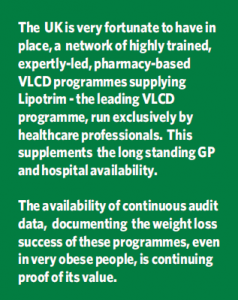 Calories needed (Calories entering the body from the outside) is determined by the nutrient content of the food consumed. Without supplements, the nutrient availability in ordinary foods is sufficiently diffuse that it is virtually impossible to construct a nutrient-complete diet that adds up to less than 1200 Calories daily. With a normal food diet, cutting the Calorie intake below 1200 Calories creates inevitable nutrient deficiencies and the dieter becomes ill. A modern nutrient complete VLCD is simply an enteral feed with sufficiently low fat that many of the daily Calories have to be drawn from the fat reserves of the body. That is what is commonly known as a “diet”.
Calories needed (Calories entering the body from the outside) is determined by the nutrient content of the food consumed. Without supplements, the nutrient availability in ordinary foods is sufficiently diffuse that it is virtually impossible to construct a nutrient-complete diet that adds up to less than 1200 Calories daily. With a normal food diet, cutting the Calorie intake below 1200 Calories creates inevitable nutrient deficiencies and the dieter becomes ill. A modern nutrient complete VLCD is simply an enteral feed with sufficiently low fat that many of the daily Calories have to be drawn from the fat reserves of the body. That is what is commonly known as a “diet”.
Very Low Calorie Diets have been in worldwide use for more than 30 years with a tremendous safety record. Although they may differ somewhat in their composition (and in the professional competence of those monitoring the programme) they have been repeatedly shown to be very safe. Safety of use is determined entirely by recognition of the concurrent medical conditions at the time of use. For example, the use of a VLCD by a diabetic patient needs the doctor to stop hypoglycaemic medication prior to the patient dieting. If the weight loss reduces blood pressure in a patient using anti-hypertensive drugs, the patient may become overmedicated. If a person diets while they are being assessed for thyroid hormone supplementation, the blood thyroxin levels will be inaccurate and the dose will be wrong. These diets really work and therefore care is needed in selection and monitoring of patients. The provision of a proper maintenance programme (not always available from various VLCD purveyors) makes a great difference in the prevention of recidivism. Long tem outcomes are therefore programme specific.
APPROPRIATE VLCDs SAVE LIVES
Don’t let sensationalist language used in media reporting hinder patients benefiting from a valuable mode of treatment. Properly formulated and monittored VLCDs save lives. Appropriate maintenance formulations help reduce recidivism.
There is considerable long -standing scientific literature demonstrating that the rapidity of weight loss confers additional positive health benefits (independent of the actual amount of weight which is lost) when compared with food-based diets or higher energy level formula diets. This applies particularly to non-insulin dependent diabetes mellitus (see, for example Lean et al2),1990; Henry & Gumbiner, 1991; Wing et a1,1991 (4); Hernandez-Bayo et a1,1985(5), Paisey 1998(6) in which metabolic control and lipid profile is markedly improved by the rapid fall in weight using VLCD. Wider recognition of this and much more literature, as well as the current experience of over 2000 pharmacists and GPs using Lipotrim will hopefully put an end to the use of off-putting language which discourages acceptance of an important medical tool.
References
1. Lim E. L et al Reversal of type 2 diabetes: normalisation ofbeta cell function in association
with decreased pancreas and liver triacylglycerol Diabetologia D0110.1007/s00125-011-2204-7
2. Lean MEJ, Powrie JK, Anderson AS Et Garthwaite PH. Obesity, weight loss and prognosis in type 2 diabetes. Diabetic Med, 7: 228-233, 1990.
3. Henry RR Et Gumbiner B. Benefits and limitations of very low calorie diet therapy in obese
NIDDM. Diabetes Care, 14:802-823, 1991.
4. Wing RR, Marcus MD, Salata R, Epstein LH, Miaskiewicz S Et Blair EH. Effects of a very low calorie diet on long term glycemic control in obese type II diabetic subjects. Arch Int Med,
151: 1334-1340, 1991.
5. Hernandez-Bayo JA, Herranz L et al. Factors related to successful outcome after rapid weight loss in obese patients. Internat J Obes 19 Supp12: 379S, 1995. with NIDDM.
6. Paisey RB, Harvey P, Rice S et al. An intensive weight loss programme in established type 2 diabetes ans controls: effects on weight and atherosclerosis risk factors at 1 year. Diabetic Med 15: 73-79,1998.
PDF version: 9-1-Lipotrim Advertorial gp final
DIABETES – WEIGHT MANAGEMENT
Contents
Foreword 3 John Hancock, Editor
Diabetes and Obesity
A Modern Problem; an Eternal Obstacle 3
Stephen Kreitzman Ph.D, R.Nutr. Valerie Beeson, Shawm Kreitzman, Howard Foundation Research, Cambridge UK
The Case for VLCDs over Medication Benefits of Rapid Weight Loss Overeating Akin to Alcoholism The Lipotrim Alternative
No Excuse for the Current Level of Type 2 Diabetes
Prevention More Cost Effective than Treatment 10
John Hancock
Prevalence and Impact A Range of Solutions Shortfalls in Care
A Lack of Awareness
Prevention More Cost Effective than Treatment Stronger Together
Lipotrim
Reform to Rethink
Make What Works Work Well 12
Not Unseen but not Understood
A Realistic and Achievable Programme Achieving and Maintaining a Healthy Weight An Integrated Approach
Education for Better Outcomes
Lipotrim 14 Camilla Slade, Staff Writer
Too Much and Too Little Less Calories, Less Weight
Reform to Rethink 15
Camilla Slade, Staff Writer
GPs at the Heart of Things NHS Diabetes
Getting it Right Matters Nutrition
Summary
Make What Works Work Well 17
John Hancock
Facing the Real Issue
Different Solutions; Same Objective Planned, Agreed and Appropriate
References 18
USE OF VERY LOW ENERGY, NUTRIENT COMPLETE FORMULA FOODS, AS TOTAL FOOD REPLACEMENT FOR WEIGHT CONTROL
 To fully understand the medical value of nutrient- complete formulated foods as a tool for weight management, there are a few fundamental concepts that need to be explained. These include the protein sparing modified fast; the mechanisms and value of ketogenic diets, minimum safe energy intakes and enteral food formulas. The value of this approach is amply demonstrated by substantial clinical evidence accumulated over a period of nearly 40 years.
To fully understand the medical value of nutrient- complete formulated foods as a tool for weight management, there are a few fundamental concepts that need to be explained. These include the protein sparing modified fast; the mechanisms and value of ketogenic diets, minimum safe energy intakes and enteral food formulas. The value of this approach is amply demonstrated by substantial clinical evidence accumulated over a period of nearly 40 years.
Beginning in 1975, a series of reports from the Bistrian and Blackburn medical team demonstrated the value of a very low-energy dietary regime for weight management in a variety of difficult obese patients. This team had the advantage of considerable nutrition expertise and they devised a protein sparing modified fast — essentially a home-concocted Very Low Calorie Dietary formulation that was nutrient complete. Unfortunately the remarkable success (and safety) of this approach was obscured by commercial greed – not by the medical team, but by external commercial exploitation. A commercial product was developed and widely sold that contained virtually no nutrition. it was based upon a hydrolyzed nutritionally incomplete protein (collagen) in cherry syrup. This product was heavily promoted and widely hyped and inevitably, it resulted in a number of deaths.
Quite properly, the Liquid Protein Diets have not been available since the late 1970s. Unfortunately however, a total lack of nutritional understanding led to the assumption that low energy liquid formulations were dangerous as a concept. In fact there are now nearly 40 years of worldwide experience with numerous properly formulated nutritionally complete products which should be evidence enough of safety.
There is an often stated mantra, surprisingly even from nutrition specialists, that there must be some level of calorie intake (in the neighbourhood or 1000 to 1200 calories per day) below which diets become unsafe. Once again, it is simply the superficial understanding of food and nutrition biochemistry that has given this notion some credence. All common foods may be thought of basically as recycled nutrients from the plants and animals we choose to consume. All are complex formulations of the chemicals that make up the composition of those plants and animals. Many of these chemicals are common to all living things and some of them are useful and even necessary for human health. They also contain large numbers of chemicals that are either inert or toxic to other animals, including humans. The key point, however, is that there is no naturally occurring food that contributes all the required nutrients for humans. We therefore require a varied diet to attempt to create a mix that will maximize the chemistry we need and minimise the problematic substances.
The crucial point here is that – given the varying chemistry of the plants and animals we consume — it is virtually impossible to assemble a nutrient-complete daily diet with a total of less than around 1200 calories. When food diets with lower calorie intakes are provided, nutrient deficiencies invariably cause illness. It is very important to note here that it is the nutrient deficiencies — and not the low calorie count — that causes the problems.
When it became clear that nutrient complete enteral feeds could be provided that contained, by design, all the essential nutrients, it demonstrated that the minimum calorie intake was nowhere near the 1200 calorie barrier. In fact, modern formulations have a calorie component determined primarily by the calorie contribution of the essential amino acids and essential fatty acids (and to a lesser extent by the lactose from the necessary milk component, which provides very high quality proteins to the formulations). These limits however are closer to 400 calories per day, not 1200.
The most effective and safe formulations are those that induce ketosis. Ketones are a by-product of the incomplete breakdown of free fatty acids. They are essential for sparing protein utilization and helpful in controlling the hormonal balance between insulin and giucagon, which helps control hunger. Many of the body’s tissues can use free fatty acids as fuel, but critically there are a few (including the brain) that cannot. Unless there are sufficient ketones present, which are water soluble and can pass through the blood brain barrier to provide energy for brain function and survival, the body must de-aminate amino acids from proteins to create glucose. Glucose can not be created from fat. This is why ketones are protein sparing. Virtually all tissues, with the possible exception of liver, can use ketones for energy.
It is clear from the controlled accessibility of very low energy diets through healthcare professionals, that detailed records are available of the successful results of this form of treatment. A large number of these results have been published. Proper nutrition, provided in defined very low calorie formulations, results in maximum safe rates of weight loss and there is considerable evidence to support its value to modern medicine.
S.N Kreitzman Ph.D, R.Nutr. (UK Registered Nutritionist)
V. Beeson Howard Foundation Research Ltd.
PDF version: 8-1-nhsta0002a
